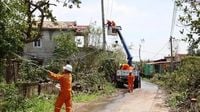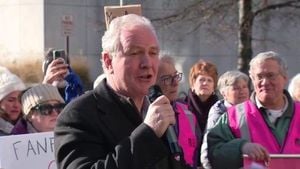In the days following the relentless rains and storms that battered northern and central Vietnam in mid-October 2025, communities in Gia Lai and Hanoi have been grappling with the aftermath—ranging from catastrophic landslides and flooded neighborhoods to widespread power outages. As local authorities, residents, and agencies mobilize to restore normalcy, the scale of the challenges and the resilience on display have drawn national attention.
Nowhere is this more evident than in Gia Lai province, where on October 20, Vice Chairman of the Provincial People’s Committee, Nguyễn Hữu Quế, made a direct inspection of a severe landslide along Lê Hồng Phong road in Ia Ly commune. This route, crucially, is the only access to the 500kV Opy Station and the Ialy Hydropower Plant, both vital for the region’s electricity supply and economic activity. According to VietNamNet, the landslide first appeared in 2021, initially stretching about 70 meters, with erosion cutting 30 meters into the concrete surface and forming a vertical drop of up to 10 meters. In some places, makeshift barriers—concrete piles and old tires—were the only things preventing the road from collapsing further, leaving a precarious width of just 1.2 meters for passage.
Despite these dangers, local residents had little choice but to continue using the damaged road for daily travel and agricultural work, even as the risk of disaster loomed. The situation deteriorated rapidly after the most recent storms: by October 20, the landslide had extended to approximately 320 meters, with over 100 meters of the concrete road completely broken and sunken by about 6 meters, effectively paralyzing traffic. The destruction didn’t stop at infrastructure—entire swathes of crops and several homes perched on the uphill slope were swept away. One resident, Lê Văn Yên, saw his house nearly obliterated, with only the front wall and gate remaining intact.
Recognizing the immediate peril, Vice Chairman Nguyễn Hữu Quế ordered the local authorities to cordon off the affected area and prohibit all passage to protect lives. "Alongside deploying police and militia to maintain safety, the local government must relocate all six affected households from the danger zone, securing both people and property," he emphasized, as reported by VietNamNet. Provisions for temporary accommodation and financial support for renting homes were also mandated. For those who lost everything, such as Mr. Yên, Quế promised, "I will report to the provincial leadership to propose additional support, helping the family minimize their losses."
Efforts to assist residents began immediately. On October 19, local officials had already moved Mr. Yên’s family to safety, while other households were given time to pack and dismantle their belongings, with over 30 staff members mobilized to help. The plan, according to local leaders, is to fully evacuate all affected families and assess whether the road can be reinforced. If not, permanent resettlement on public land will be arranged.
The Lê Hồng Phong road, built in 1996 by the Ialy Hydropower Company to facilitate construction of the power plant, has recently been the subject of jurisdictional wrangling. While the company sought to hand over management to local authorities, the provincial government insisted the company remain responsible for maintenance and repairs. The urgency is clear: without swift intervention, both public safety and regional energy security could be compromised. The company has been instructed to coordinate with Vietnam Electricity (EVN) to secure emergency funding and begin repairs.
Elsewhere in Vietnam, the aftermath of the same storms has been felt acutely in Hanoi’s outlying districts. In Đa Phúc and Trung Giã communes, floodwaters lingered for nearly two weeks, submerging homes and leaving more than 200 households without electricity. According to Hanoi’s local news, as of October 20, the situation had finally improved: the water had receded, and Sóc Sơn Electricity Company, working closely with local officials, launched a meticulous inspection campaign to safely restore power.
Nguyễn Minh Cam, Technical Deputy Director of Sóc Sơn Electricity Company, explained to the press, "We coordinate with local authorities to broadcast announcements and visit each household to inspect. When safety is ensured for each home, we restore power in order of priority. We can’t switch on electricity for all 200 households at once, because this area was under four meters of water for 11 days. Even though the water has receded, the roads are still damp, so we’ll check carefully to ensure maximum safety for residents."
The numbers are staggering: over the past week, more than 36,000 customers across Hanoi had their electricity restored. For the last 200 or so households in Đa Phúc and Trung Giã, power was expected to return by October 21, signaling a near-complete recovery for the capital’s hardest-hit areas. Residents, who had endured days without water or electricity, wasted no time cleaning up and returning to daily routines as soon as services resumed.
These events have unfolded against a backdrop of ongoing efforts to strengthen disaster response and public administration. On October 21, Gia Lai also hosted the opening ceremony for an advanced professional training class focused on inspection and supervision work within the Party apparatus. The training, attended by 699 officials from four provincial Party Committees and 135 commune-level inspection committees, is part of a broader push to boost the quality and effectiveness of oversight, especially as Vietnam’s governing bodies face increasing demands for transparency and accountability.
The four-day program, running through October 24, covers nine specialized topics, including Party discipline enforcement, complaint resolution, digital transformation, document management, and the financial oversight of Party organizations. As Nguyễn Minh Quang, Deputy Chairman of the Central Inspection Committee, stated at the opening, "To enhance the fighting strength of Party organizations and members, especially today, one of the top priorities is to improve the quality, effectiveness, and efficiency of inspection and supervision work." He added, "The Central Inspection Committee regularly focuses on professional training to improve the expertise and capacity of those responsible for inspection and supervision within the Party. Through these courses, participants are updated on new directions from the Politburo, Secretariat, and Central Inspection Committee, adapting to digital transformation and administrative reform, and applying them immediately to their practical work."
Quang urged participants to fully engage with the curriculum, actively discuss real-world challenges, and rigorously follow class protocols to ensure safety and effectiveness. He also called on instructors to share practical skills and address the specific concerns of attendees, with a focus on real-life scenarios encountered in inspection and supervision.
The convergence of natural disasters, infrastructure crises, and institutional reforms in Gia Lai and Hanoi over the past week underscores both the vulnerabilities and strengths of local communities and governance. As residents rebuild and officials push for modernization, the hope is that lessons learned from these trials will lead to greater resilience and preparedness for whatever challenges lie ahead.




